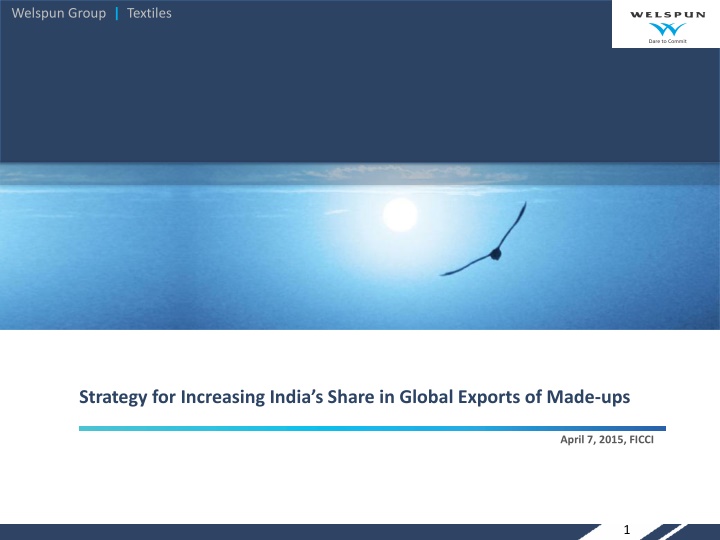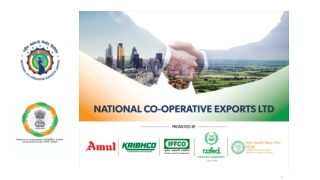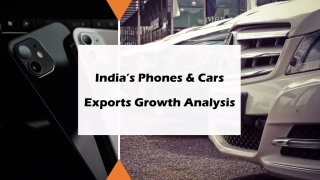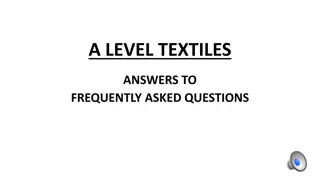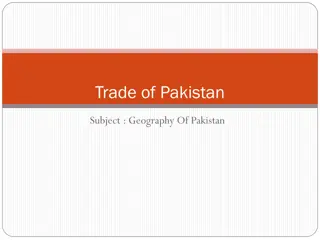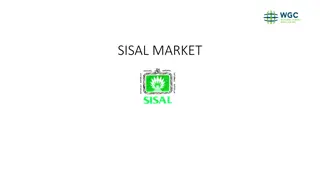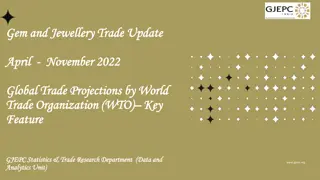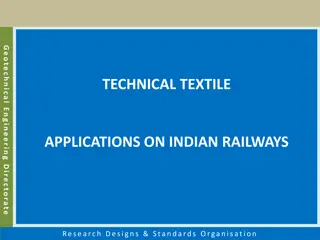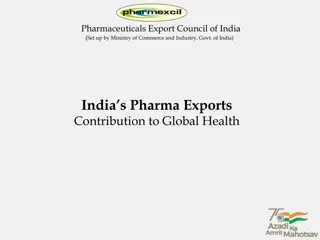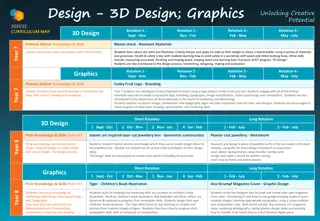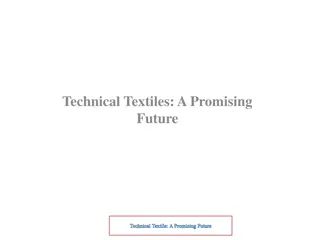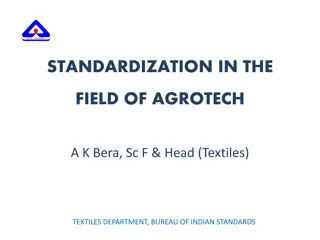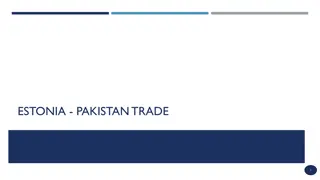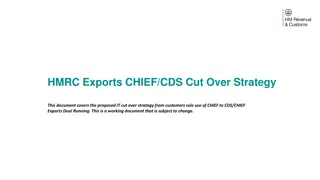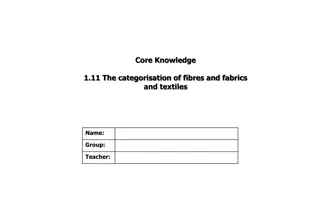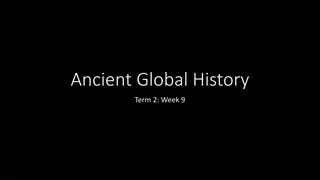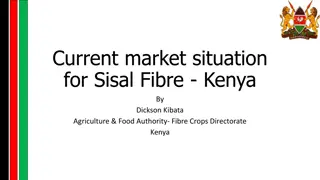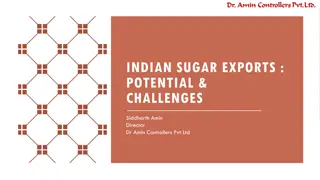Welspun Group Textiles - Strategy for Global Exports
Welspun Group discusses the significance of 2015 in the global textile industry, emphasizing the emergence of a quota-free world. The presentation showcases global shares of textile exports, market trends, and leadership in made-ups exports. Insights on the evolving landscape of textile trade and growth projections are highlighted.
Download Presentation

Please find below an Image/Link to download the presentation.
The content on the website is provided AS IS for your information and personal use only. It may not be sold, licensed, or shared on other websites without obtaining consent from the author.If you encounter any issues during the download, it is possible that the publisher has removed the file from their server.
You are allowed to download the files provided on this website for personal or commercial use, subject to the condition that they are used lawfully. All files are the property of their respective owners.
The content on the website is provided AS IS for your information and personal use only. It may not be sold, licensed, or shared on other websites without obtaining consent from the author.
E N D
Presentation Transcript
Welspun Group | Textiles Welspun Group | Textiles Strategy for Increasing India s Share in Global Exports of Made-ups April 7, 2015, FICCI 1
Welspun Group | Textiles Significance of 2015 for Global Textile Industry Emergence of Quota Free World 1st January, 2005 It s a decade of Quota Free World. 2
Welspun Group | Textiles Consuming World and Producing World Consuming Countries Producing Countries 3
Welspun Group | Textiles Global Share of Textile & Made Ups Exports (Excluding Apparel) Global Export of Textiles 2005 (Value %) Global Export of Textiles 2014 (Value %) Japan, 2% Japan, 3% Pakistan, 3% Others, 11% Others, 8% Pakistan, 3% Chinese Taipei, 3% Chinese Taipei, 5% China, 20% Hiong Kong, China, 4% China, 35% Hiong Kong, China, 7% Korea, Rep., 4% Turkey, 4% European Union (28), 35% Korea, Rep., 5% United States, 5% European Union (28), 24% Turkey, 3% United States, 6% India, 6% India, 4% Value of Exports - US$ 218 bn Value of Exports - US$ 338 bn China has emerged as most competent Textile Economy in Quota Free World. Source: UN Comtrade, Wisedge Analysis 4
Welspun Group | Textiles Global Textile Market Global Textile and Apparel Trade Category wise Share of Global Trade (2013) US$ bn 1400 Made Ups, 4% 1180 Other, 10% 5.9% CAGR 1200 6.6% CAGR Fibre, 6% 1000 770 723 800 707 Yarn, 7% 600 473 Apparel, 56% 400 200 Fabric, 17% 0 2005 2011 2012 2013 2020 Global textile and apparel trade recovered in 2013 and is expected to grow @ 6.6% for next 7 years and reach a size of US$ 1.18 trillion by 2020 Source: UN Comtrade, CII Knowledge report and Wisedge Analysis 5
Welspun Group | Textiles Steady Growth in Made Ups Global Trade Global Made Ups Trade Trend 40.0 1.5 35.0 CAGR 2005-12 1.5 1.4 1.4 8.2 30.0 5% 7.7 Table Linen 1.2 7.4 7.2 25.0 Other Home Linen 7% 6.3 US$ bn Bed Linen 20.0 12.5 1.0 6% 11.8 11.2 12.0 4.5 Furnishing 6% 10.4 15.0 Blankets 10% 7.6 10.0 8.5 Grand Total 6% 8.0 7.6 7.6 6.8 5.0 5.1 5.3 4.8 4.4 3.9 3.3 2.3 0.0 2005 2010 2011 2012 2013 2014 Home textiles / made-ups trade has grown at a steady pace with bed linen having the highest trade share and higher growth in Blankets *Data for 2013 and 2014 is being extrapolated on the basis of CAGR 2005-12 Source: UN Comtrade 6
Welspun Group | Textiles Made Ups Exports Leadership - FY2012-13 Global Exports of Made Ups - FY 2012-13 (Top 5) 48% 10% 8% 2% 5% China Pakistan India Turkey Bangladesgh 7
Welspun Group | Textiles China s GDP Per Capita GDP Per Capita China (2000 2013 8,000 6,807 7,000 6,000 4,433 5,000 current US$ 4,000 China 3,000 1,490 2,000 949 1,000 0 2000 2001 2002 2003 2004 2005 2006 2007 2008 2009 2010 2011 2012 2013 GDP per capita is gross domestic product divided by midyear population. GDP is the sum of gross value added by all resident producers in the economy plus any product taxes and minus any subsidies not included in the value of the products. It is calculated without making deductions for depreciation of fabricated assets or for depletion and degradation of natural resources. Data are in current U.S. dollars. Source: worldbank.org 8
Welspun Group | Textiles Agenda 1. Learning from China s Strategy 2. Shifting International Trade Pattern 3. India s Strategy 9
Welspun Group | Textiles Agenda 1. Learning from China s Strategy 2. Shifting International Trade Pattern 3. India s Strategy 10
Welspun Group | Textiles Comparison of GDP Per Capita GDP Per Capita - India vs China (2000 2013) 8,000 6,807 7,000 6,000 4,433 5,000 current US$ China 4,000 India 3,000 1,490 1,417 2,000 1,499 949 740 1,000 457 0 2000 2001 2002 2003 2004 2005 2006 2007 2008 2009 2010 2011 2012 2013 GDP per capita is gross domestic product divided by midyear population. GDP is the sum of gross value added by all resident producers in the economy plus any product taxes and minus any subsidies not included in the value of the products. It is calculated without making deductions for depreciation of fabricated assets or for depletion and degradation of natural resources. Data are in current U.S. dollars. Source: worldbank.org 11
Welspun Group | Textiles China 2005 to 2015 Global Hub for manufacturing World s largest manufacturing economy World s largest exporters of the goods [$2.34 trillion (2014)] World s largest economy by purchasing power parity (PPP) [$19.230 trillion (PPP; 2014)] Second largest importer in of goods [$1.96 trillion (2014)] GDP - $9.24027 trillion (current US$, 2013) GDP per Capita - $6,807 (current US$, 2013) Average Growth Rate - 10% (over past 30 years) Population below poverty line - 6.1% (2013) Labour Force - 787.6 million (2012) Unemployment - 4.1% (Q2, 2014) Source: worldbank.org, www.wikipedia.org 12
Welspun Group | Textiles China s Game Plan To build-on the strength of the large population, a low skill industry to alleviate poverty and to build infrastructure for future value added high-tech manufacturing. 13
Welspun Group | Textiles China s Strategy Aggressively Adjusting Industry Structure o China government made some aggressive decisions and executed them in disciplined way. Artificially Undervalued Currency o In 2005, China held Renminbi (Yuan) at undervalued rate by pegging it to USD. o This led to improve competitiveness of Chinese textile exporters. FDI o Increased flow of Foreign Direct Investment by foreign companies established through Joint Ventures employed investments on machines, plant, technology and skills. Location of parks near Coast Line Textile parks are located near coast line to strengthen supply chain Economies of Scale o Large scale manufacturing unit to gain economies of scale 14
Welspun Group | Textiles China s Strategy Improve Competence by Shifting Focus from Pricing to Costing o Low price points to gain market share Focus on Total Costs Superiority o Efforts was made to reduce all the cost elements such as labour cost, cost of materials etc. Compliance of Social and Labour Standards o Adherence to compliances like social responsibility, child labour, health and safety, e.g. SA 8000 widely adopted by Industry. Strengthen Supply Chain o Focus on making an efficient system and optimum resource allocation o Enlarge market, build up more marketing channels and gain controlling right in global supply chain. o Development of Industrial Parks near coastal area. 15
Welspun Group | Textiles China s Strategy Aggressive Skill Development Programme o Vocational and Education training integration with Schooling. o Stipend programme for Secondary School Education in rural areas o Regulations in Law such as Citizens shall have the right to receive vocational education. 16
Welspun Group | Textiles Skill Development: The Chinese Model VET System in China School and Outside school system Vocational Education and Training (VET) Outside School System School based Primary Education Pre-employment training, On the job training Adult training, Re- employment training Junior Secondary Vocational Junior Secondary Employment Training Centre Private Training Centre Enterprise sponsored Training Centre Vocational Senior Secondary Regular Specialised Secondary Adult Specialised Secondary Skilled worker / Technical Schools Senior Skilled Workers School Senior Secondary Vocational Senior Secondary General Higher Education Junior vocational/specialised colleges Technician colleges Polytechnic colleges Vocational Higher Education Employment 17
Welspun Group | Textiles Number of Vocational Training Institutions and Trainees in 2006 Number of Training Institutions Type Number of Trainees Technical Schools 2,855 27,03,000 Employment Training Centres 3,289 79,72,000 Private/Civilian-run training centres/NGOs 21,425 1,90,50,000 Enterprise-sponsored training centres 22,000 3,00,00,000 Source: www.ccsenet.org, International Business Research, Vol.1- No.3, 2008 18
Welspun Group | Textiles Sources of Educational Funds Year 2010 Sources of Fund for Education Amount (billion Yuan) Source 1% 3% 1% A. Government Appropriation for Education 1467.01 B. Funds from Private Schools 10.54 21% C. Donations and Fund raising for running schools 10.79 D. Income from Teaching, Research and other Auxiliary Activities and Tuition & Miscellaneous Fees E. Other Educational Funds 410.61 75% 57.24 Total Fund (A+B+C+D+E) 1956.18 Government Finances Income from Teaching and Research Other Educational Funds Funds from Private Schools 1956.18 bn Yuan = INR 19,75,742 Crores [@ Exchange rate 1 CNY = 10.1 INR] Donationas and Fund raising Source: www.ccsenet.org, International Business Research, Vol.1- No.3, 2008 19
Welspun Group | Textiles Agenda 1. Learning from China s Strategy 2. Shifting International Trade Pattern 3. India s Strategy 20
Welspun Group | Textiles Shifting International Trade Pattern After setting the trade free from quantitative (quota) restrictions, USA and EU have tried to influence the trade by creating trade blocks and preferential access by means import duties. USA, EU and Japan traditionally had threat perception about each other . For the first time these three are joining hands for trade. TPP (Trans Pacific Partnership) (12 Countries) Australia, Brunei, Canada, Chile, Japan, Malaysia, Mexico, New Zealand, Peru, Singapore, USA and Vietnam TPP covers product standards and .. Intellectual Property rights, FDI, Competition policy, Environment, Labour, State owned Enterprise policies, E-commerce, Govt. Procurement, Technical Barriers to trade, transparency in Health care technologies and pharmaceuticals regulatory coherence. 21
Welspun Group | Textiles Shifting International Trade Pattern TPP controls over 35% of World Trade (Over 50% along with TIPP). The Countries outside TPP will suffer loss of market access due to non tariff measures. TPP is likely to be YarnForward ROO (Rules of Origin Agreement). The Chinese Textile Industry is shifting base to Vietnam. TIPP (Trans Atlantic Trade and Investment Partnership) USA and EU RCEP (Regional Comprehensive Economic Partnership) (16 Countries) China, Japan, South Korea, Australia, New Zealand , India, Brunei, Myanmar, Cambodia, Indonesia, Laos, Malaysia, Philippines , Singapore, Thailand and Vietnam GSP+ by EU to Pakistan Huge disadvantage for India as need to face loss of 9.6 to 10% 22
Welspun Group | Textiles EU-India FTA EU- India FTA being discussed for a long time. Major beneficiary is going to Textiles & Apparels sector. It will help Indian Textile Products become cost competitive w.r.t. other competing countries like Pakistan, Bangladesh & Vietnam Job Creation Rise in Trade Purchasing Power Free Trade Agreement New Investment It is projected that once the FTA is signed, Indian Textiles & Apparels exports are set to increase by US $ 5 Bn. 23
Welspun Group | Textiles Various FTAs Vietnam is the only Garment Producing country. If TPP comes into force then Vietnam will have a preferred access to US market. China is likely to use this opportunity by migrating textile industry to Vietnam TPP TIPP EU Canada Chile Mexico Peru USA Vietnam India Australia Japan New Zealand Malaysia Brunei Malaysia Singapore Vietnam AIFTA RCEP TPP Trans Pacific Agreement TIPP Trans Atlantic Trade and Investment Partnership RCEP - Regional Comprehensive Economic Partnership AIFTA ASEAN India Free Trade Area Indonesia, Philippines, India Thailand, Laos Myanmar Cambodia China
Welspun Group | Textiles India s Position in Global Market 14.1% Contribution to Industrial Production of country. 2nd Largest Employer in India. Employs around 35 Mn workforce 4% Contribution to India s GDP 17% Contribution to Exports Earnings FY12-13 22% of World Spindles Capacity Highest # looms in World World s # 1 Producer of Jute World s # 2 Producer of Silk 25 World s # 1 Producer of Cotton 25
Welspun Group | Textiles India's Textile & Apparel Exports 2013-14 (%) Others, 6% Made Ups, 12% Apparel, 40% Fibre, 12% Fabric, 12% Yarn, 18% Apparel constitutes about 40% of India s textile exports, whereas Made Ups at 12% Source: Office of Textile Commissioner 26
Welspun Group | Textiles Individual Product Cost Contribution of various factors in Product Cost 1.00%1.00%3.50%4.00% 4.00% 2.50% 0.50% 1.00% 5.00% 6.00% 57.00% 3.00% 1.00% 3.50% 7.00% Raw Material Steam Cost Repair & Maintenance Marketing Expenses Labour Dyes and Chemical Capital Interest Rate Corporate Expenses Power Cost Packing Material Depreciation Other Cost Water Cost Stores & Spares Plant Overheads Key elements such as Raw material, Labour, Power , waster and Steam cost contributes more than 74% of cost of the product.
Welspun Group | Textiles Utility cost comparison Comparison with Competitors in 2012 Parameters India Bangladesh Indonesia Egypt China Pakistan Turkey Labour wages (US $ / month) 135 87 226 226 328 127 839 Power Rate (US cents / Kwh) 11.29 8.13 8.51 3.49 12.29 10.62 10.24 Raw Water Cost (US cents / m3) 39.57 29.26 49.19 10.48 53.26 25.67 30.73 Steam (US cents / kg) 1.44 1.3 1.16 1.75 1.64 1.24 2.1 Capital Interest Rates (%) 8 13 9 11.5 5 to 6 7 10 Source: Texprocil Benchmarking Report 28
Welspun Group | Textiles Utility cost comparison Comparison with Competitors in 2012 Parameters India Bangladesh Indonesia Egypt China Pakistan Turkey 87 `` Labour wages (US $ / month) 135 226 226 328 127 839 3.49 `` Power Rate (US cents / Kwh) 11.29 8.13 8.51 12.29 10.62 10.24 25.67 `` Raw Water Cost (US cents / m3) 39.57 29.26 49.19 10.48 53.26 30.73 1.16 `` Steam (US cents / kg) 1.44 1.3 1.75 1.64 1.24 2.1 5 to 6 `` Capital Interest Rates (%) 8 13 9 11.5 7 10 As India is not competitive in utilities, need to concentrate on improvement of these areas through Skill Development, Labour Reforms, Government support. Source: Texprocil Benchmarking Report 29
Welspun Group | Textiles Agenda 1. Learning from China s Strategy 2. Shifting International Trade Pattern 3. India s Strategy 30
Welspun Group | Textiles India s Strategy India need to build a strategy to capture maximum share in consuming world i. e. US and Europe. India needs to take cognizance of shifting global trade patterns due to various FTAs 31
Welspun Group | Textiles Adverse Factors Vanishing Export Incentives due to GST implementation and WTO compliance. Higher cost of Finance because discontinuation of interest subvention scheme. Continues to have low labour efficiency and productivity compared to China. Continues to be poor deficient so have no scope for low power rates. 32
Welspun Group | Textiles SWOT Analysis Indian Textiles Industry STRENGTHS WEAKNESSES Abundant RM Supply Low wages Large skilled/unskilled population Low efficiency Lower Productivity Lack of scale of economies Exchange rate OPPORTUNITIES THREATS Free Trade Agreement with EU Rising incomes, spending power in domestic market Trans-Pacific Partnership Competition from Free Market Access Countries 33
Welspun Group | Textiles SWOT Analysis Indian Textiles Industry Opportunity for Cotton Made Ups Business 34
Welspun Group | Textiles SWOT Analysis Indian Textiles Industry Competitive Advantage 35
Welspun Group | Textiles SWOT Analysis Indian Textiles Industry Ensured availability of manpower 36
Welspun Group | Textiles SWOT Analysis Indian Textiles Industry Labour Reforms Skill Development 37
Welspun Group | Textiles SWOT Analysis Indian Textiles Industry Large Mega Parks Encourage large private Integrated Manufacturing unit by incentives 38
Welspun Group | Textiles SWOT Analysis Indian Textiles Industry Exporters should hedge the risk of rate fluctuation 39
Welspun Group | Textiles SWOT Analysis Indian Textiles Industry STRENGTHS WEAKNESSES Abundant RM Supply Low wages Large skilled/unskilled population Low efficiency Lower Productivity Lack of scale of economies Exchange rate OPPORTUNITIES THREATS Free Trade Agreement with EU Rising incomes, spending power in domestic market Trans-Pacific Partnership Competition from Free Market Access Countries 40
Welspun Group | Textiles EU-India FTA EU- India FTA has many resolved and unresolved demands, those are listed as below: Sr # Demand State 1 Textiles Resolved 2 Automobile Sector Unresolved 3 Financial Services Sector Unresolved 4 Legal Sector Unresolved 5 Whisky and Wines Almost Resolved 6 Accountancy Unresolved 7 Government Procurement Unresolved 8 ITES (EU wide Work Permit) Unresolved Status of Data Secured Nation 9 Unresolved 41
Welspun Group | Textiles SWOT Analysis Indian Textiles Industry STRENGTHS WEAKNESSES Abundant RM Supply Low wages Large skilled/unskilled population Low efficiency Lower Productivity Lack of scale of economies Exchange rate OPPORTUNITIES THREATS Free Trade Agreement with EU Rising incomes, spending power in domestic market Trans-Pacific Partnership Competition from Free Market Access Countries 42
Welspun Group | Textiles Strategy Availability of Raw Material and Manpower Abundant raw material and large population definitely support the strategy to build large volume of made ups from India. Labour reforms should be aggressively pursued and aggressive Skill Development programmes should be launched Continued low efficiency and low productivity of labour needs to be addressed through Labour Reforms and Skill Development. Support Large Scale Operations The Government should support large mega parks and private large integrated manufacturing units for made ups manufacturing to maximise the scale of operation. 43
Welspun Group | Textiles Strategy Setup Mega Textile Parks near Port Cities Government should encourage to setup Mega Textile Parks and Large Integrated Textile Manufacturing units near port cities to minimise the time for Inland transportation. FTA with EU An Opportunity for Indian Textiles The Government should freeze FTA with EU at earliest. This will give India advantage over Pakistan. TPP (Trans Pacific Partnership) India should join TPP to avoid isolation. 44
Welspun Group | Textiles Strategy Encourage social and labour compliance to facilitate joining TPP Indian exporters need to be social and labour compliant to get into TPP. Thus Government should encourage exporters adhere to social and labour compliances by giving them incentives Launch of WTO compatible scheme India should launch WTO compatible incentive schemes to restore the incentives Announcement of Interest Subvention Scheme Interest subvention scheme for made ups and whole textile industry should be announced to lower down the cost of finance. 45
Welspun Group | Textiles Thank you !! 46
